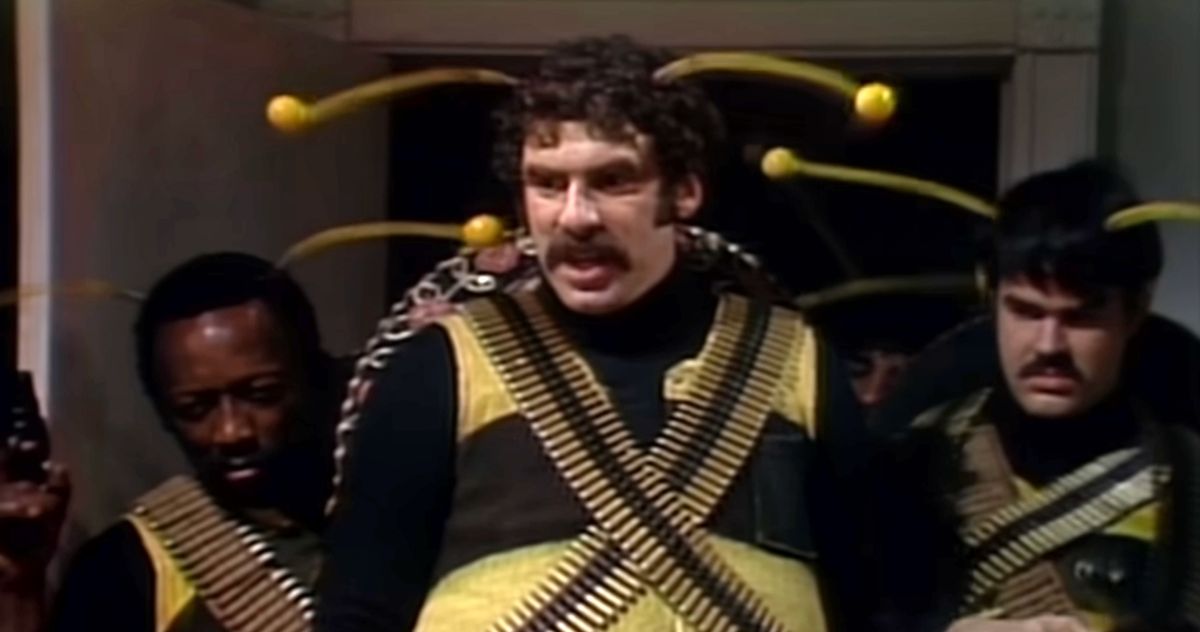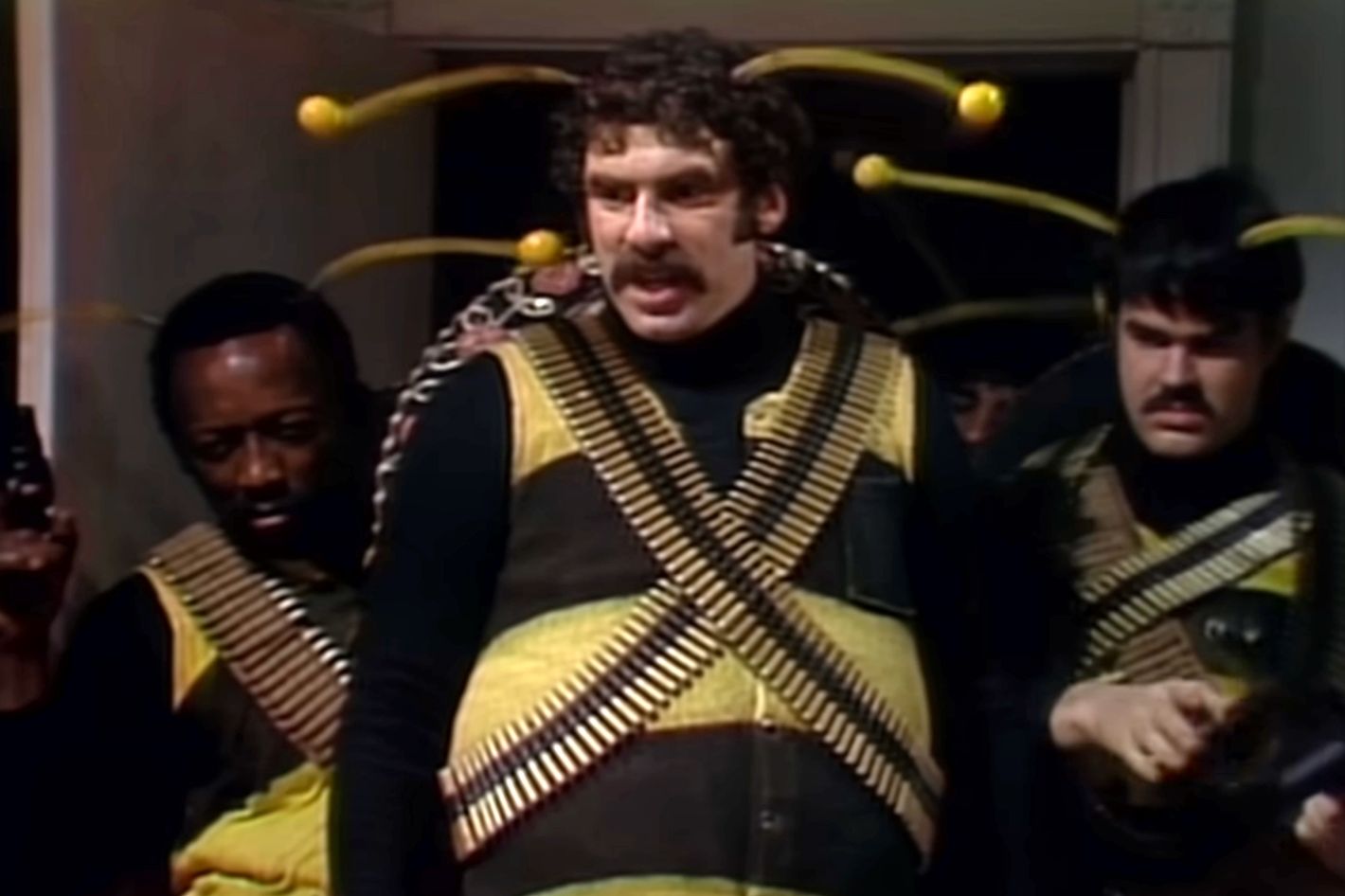SNL Has Always Been Bad
And that’s precisely what makes watching the 50-year-long live TV experiment so good.


In October 1975, Saturday Night Live premiered, and it was a mixed bag. New York, and almost every outlet that followed the show’s first season, called it “uneven.” There were bits that worked (the commercial parodies), and there were bits that didn’t (“The Land of Gortch,” featuring yucky-looking Jim Henson Muppets exploring adult themes in a fictional wasteland). There was one particularly fleshed-out sketch, in which Dan Aykroyd and Garrett Morris break into a couple’s home in an attempt to sell them on a security system. But the rest of the sketches were thinly premised, like the premiere’s “Bee Hospital,” in which male cast members play bee fathers being presented with their bee children by female cast members playing bee nurses.
The audience barely laughed at the spectacle, and NBC noticed; according to the book Live From New York, the network’s only note to Lorne Michaels after the first episode was no more bees. Michaels resurrected them for a brief appearance in the second episode, directing host Paul Simon to proclaim, “The bees number is cut. It didn’t work last week.” From there, the Killer Bees became a staple of the show’s early years and a symbol of its ethos: Sometimes, SNL was going to be bad. And 50 years in, it is the badness that makes SNL so great.
The bees made it into a total of 11 sketches that first season, prompting more and more laughs from the audience with each appearance, no matter how poorly planned or executed the recurring bit turned out to … be. That’s the thing about the spectrum of badness that has materialized on SNL in the intervening years: There are the bad sketches that activate a manic energy among the in-studio audience members, and their audible reaction makes the experience of watching disastrous SNL moments from home feel downright electric. And then there are the bad sketches that leave everyone in the in-studio audience chilled to the bone, sucking the oxygen out of your living room, too. Both versions of SNL badness are thrilling, but for different reasons.
If there is one sketch from the 50th season that epitomizes the former version of bad SNL, it’s “Gallblader Surgery,” from the December Chris Rock-hosted episode. At the top of the sketch, Rock stumbles playing a surgeon who has to alert Sarah Sherman’s nurse Leslie that she marked down the wrong organ for removal from a patient. “Wait, are you guys mad at me?” she asks in an exaggerated voice. “I feel like you guys really hate me right now.” “Hey, I’m feeling really anxious. Can I get a hug?” she adds to diminishing laughs, coming off as an under-articulated Kristen Wiig character.
The sketch remains flat like this for two minutes, until the reveal: Adam Sandler is the patient on the operating table, and when his IV malfunctions, he sprays his co-performers with fake blood. In this one sketch, there is so much bad: shaky dialogue, underrehearsed roles, technical mishaps, self-satisfied breaking. If there’s any good, it relies on the sheer fact of a celebrity cameo. But the live audience eats it all up, even when Sherman’s character whines again, “Wait, are you guys mad at me?” The audience’s reaction to the chaos doesn’t make the material any better, but it charges the sketch with an energy — an energy that feels more significant to an at-home viewer than if the sketch had simply bombed without it.
And then there are sketches that do fully bomb on live television. Take, for example, another Rock sketch from the 40th-anniversary season in 2014 called “The Arguing Couple.” Rock and Leslie Jones play an old, bitter married couple who are getting ready to go out for their anniversary while constantly hurling insults at each other. It plays more like a scene from a melodramatic play than a sketch with a clear comedic game. The first supposedly funny moment arrives when a driver (Bobby Moynihan) knocks on the door, and Jones reveals she ordered a car and then gets into the shower. (The fact that an Uber driver, dressed in a full suit no less, would come to a door adds another level of confusion.)
Jones defends her behavior — she didn’t want to get dirty while waiting for the car to arrive — and already the sketch feels convoluted. “Why are you attracting so much dirt? Are you a human Swiffer?” Rock yells with disdain. “Don’t embarrass me in front of strangers. DON’T EMBARRASS ME IN FRONT OF STRANGERS!” Jones yells back. The Uber driver is uncomfortable, and so is the audience. The exchange gets nothing more than a couple awkward titters, and home viewers can practically see the audience enthusiasm evaporating in the 8H studio. Yet Rock, Jones and Moynihan keep going, and so we keep watching from home, relishing the sadomasochism of it all.
In October 2008, there was an episode that was going as well as an episode of SNL could go. The anticipation was high because Sarah Palin was slated to appear during the cold open after weeks of Tina Fey doing her historically masterful impression of Palin. (It would end up being the most watched SNL episode of the last 30 years.) The Palin cameo was followed by a “MacGruber” runner, two huge Wiig character sketches, and a star-making performance by Adele singing her first hit, “Chasing Pavements.” The crowd couldn’t have been hotter after “Weekend Update,” in which a pregnant Amy Poehler raps on behalf of Palin.
But then came “Fart Face,” a sketch where Will Forte, Bill Hader, and host Josh Brolin play businessmen in a meeting who trade off calling each other “fart face.” The sketch bombed at dress rehearsal, and there was no reason to believe it wouldn’t bomb on air too. Before the live sketch began, Brolin, looking at the pumped-up audience, said to Forte and Hader, “Well fellas, let’s shut these fuckers up.” And that’s exactly what they did. The first time Hader calls Forte “fart face,” the audience greets the line with silence. It only gets worse for the 70+ times “fart face” is said over the next five minutes. Afterward, Hader said he couldn’t believe that the sketch aired at all, let alone that Michaels actually moved the sketch earlier in the show’s running order. Deliberately or instinctually, maybe Michaels knew that an episode that is too consistently good wouldn’t feel like SNL.
All these examples of badness highlight the dynamism that powers SNL: the sense of real risk, the constant threat that a show won’t work. What the movie Saturday Night, Jason Reitman’s fictionalization of the ninety minutes before the first episode of SNL, gets wrong is treating the chaos backstage as the thing that makes way for pristine, brilliant comedy, when what was and is most exciting about SNL is the chaos that materializes onstage. More than any one sketch in the early days, what distinguished the show was its irreverence towards itself and its willingness to release scrappy and unfinished work when everything else on TV was so polished.
This contrast might be even more vital today, when SNL is consumed largely online. Season 49’s “Beavis and Butt-Head” is now one of the most popular sketches the show has ever released on YouTube (it currently has almost 22 million views) purely because it fell apart. The sketch centers on a professor (Kenan Thompson) who, while being interviewed about the dangers of AI, gets distracted by two members of the audience who look like Beavis (Ryan Gosling) and Butt-Head (Mikey Day). Three minutes in, Heidi Gardner, who plays the interviewer who has never watched or even heard of Beavis and Butt-Head, uncontrollably breaks from seeing Day in makeup as Butt-Head. According to YouTube, the moment where Gardner fully loses it is the most-replayed part of the sketch online. The mistakes are what make SNL feel, even all these years later, like it is made by real, vulnerable people.
With the specter of failure hanging in the air, when a sketch or a moment hits, it’s transcendent. The possibility of something being bad on SNL creates a comedic tension stronger than anything created by good sketch-writing alone. In April 2000, the “More Cowbell” sketch seemed doomed to obscurity after dress rehearsal. But then, for air, Will Ferrell put on a shirt that was a size too small, Christopher Walken ramped up his performance, and Jimmy Fallon broke. In the background, one of the cone-shaped studio lights was visibly askew. “That’s not something that bothers me,” said Leo Yoshimura, SNL’s production designer who has been there since the first season, in the SNL 50: Beyond Saturday Night documentary. “Because those kinds of accidents actually allow you to think, Well, it’s live.” And what would even be the point of SNL being live, if it all worked perfectly every week?








